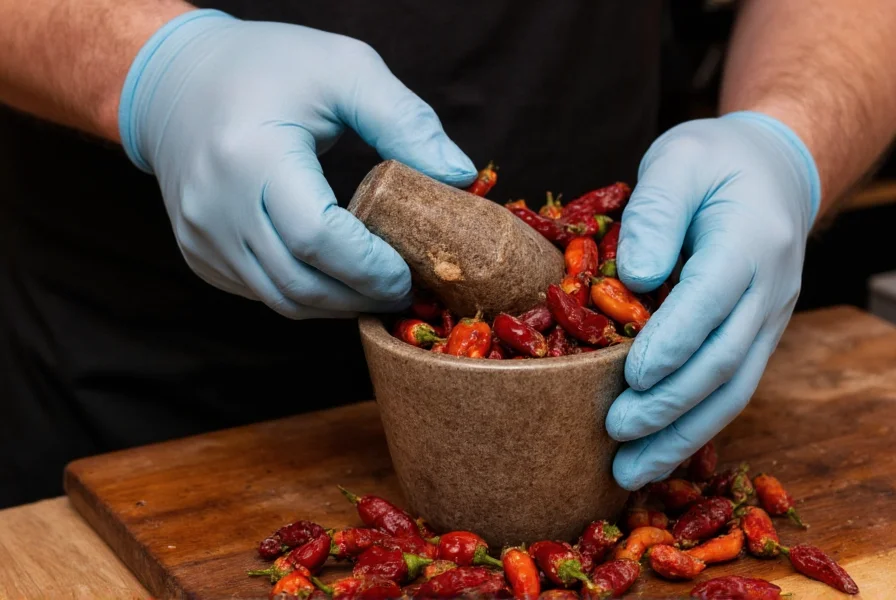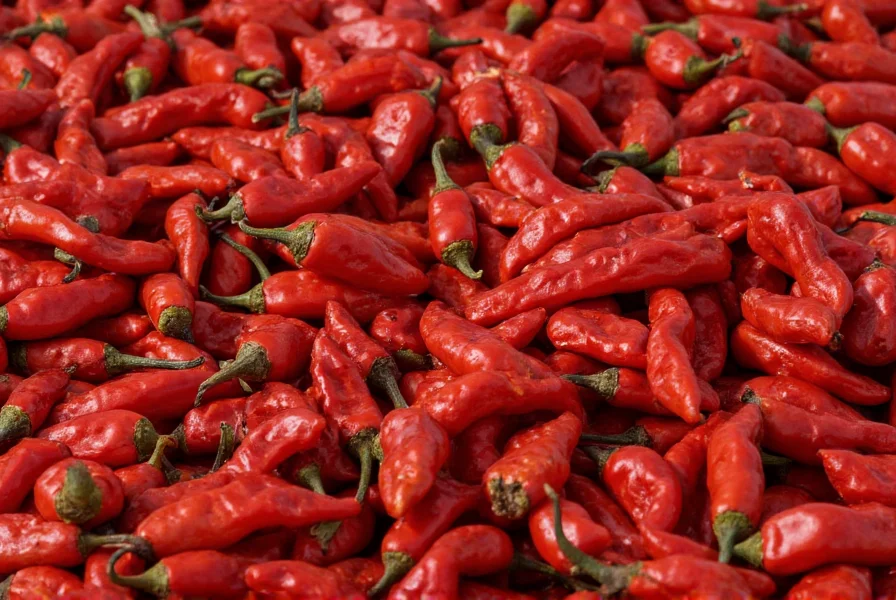Dried ghost pepper, scientifically known as Capsicum chinense 'Bhut Jolokia', represents one of the most intense culinary experiences available to spice enthusiasts. Originating from Northeast India, this legendary chili earned Guinness World Records recognition as the world's hottest pepper from 2007-2011. The drying process transforms fresh ghost peppers into concentrated flavor and heat bombs that professional chefs and home cooks use strategically to elevate dishes without overwhelming them.
Understanding Ghost Pepper Heat Levels
When evaluating how hot is dried ghost pepper compared to its fresh counterpart, the drying process actually intensifies the perceived heat. Fresh ghost peppers measure 855,000-1,041,427 SHU on the Scoville scale, while dried versions can feel even hotter due to concentrated capsaicinoids. For perspective:
| Pepper Type | Scoville Heat Units | Heat Comparison |
|---|---|---|
| Dried Ghost Pepper | 855,000-1,041,427 SHU | 400x hotter than jalapeño |
| Habanero Pepper | 100,000-350,000 SHU | 1/3 the heat of ghost pepper |
| Trinidad Moruga Scorpion | 1,200,000-2,000,000 SHU | Slightly hotter than ghost |
The drying process removes water content while preserving capsaicin—the compound responsible for heat—creating a more potent product by volume. This explains why dried ghost pepper vs fresh ghost pepper requires different handling approaches in the kitchen.
The Drying Process and Quality Indicators
Traditional sun-drying remains the preferred method for preserving ghost peppers' complex flavor profile. Properly dried ghost peppers should exhibit:
- Deep, uniform burgundy to dark red color (avoid brown or black spots)
- Crisp texture that snaps when bent
- Intact shape without excessive cracking
- Distinct smoky aroma with underlying fruity notes
Commercial producers often use food dehydrators set at 135°F (57°C) for 12-24 hours to achieve consistent results. The critical factor is maintaining temperatures below 140°F (60°C) to prevent capsaicin degradation. When evaluating ghost pepper heat level scoville consistency, properly dried peppers maintain 90-95% of their original heat potential.

Practical Storage Recommendations
Maximizing shelf life requires understanding proper dried ghost pepper storage tips. Exposure to light, moisture, and oxygen rapidly degrades both flavor and heat. Follow these evidence-based storage methods:
- Airtight containers: Use glass jars with rubber seals or vacuum-sealed bags
- Dark environment: Store in pantry or cupboard away from light sources
- Cool temperatures: Maintain between 60-70°F (15-21°C)
- Oxygen absorbers: Include food-safe oxygen absorbers in storage containers
When stored properly, whole dried ghost peppers maintain peak quality for 18-24 months. Ground ghost pepper powder degrades faster due to increased surface area, lasting 6-12 months before noticeable flavor and heat loss occurs. Never store dried peppers in the refrigerator where moisture can accumulate.
Culinary Applications and Handling Safety
Mastering how to use dried ghost pepper in cooking requires both technique and safety awareness. The concentrated capsaicin demands careful handling:
Safety precautions:
- Always wear nitrile gloves when handling
- Avoid touching face or eyes during preparation
- Work in well-ventilated area (dust particles become airborne)
- Have dairy products (milk, yogurt) nearby to neutralize accidental burns
For culinary use, consider these professional techniques:
- Rehydration method: Soak 1-2 minutes in hot water before use for sauces and stews
- Dry toast: Briefly heat in dry skillet to enhance smoky notes before grinding
- Infused oils: Steep whole peppers in oil for 2-4 weeks for controlled heat infusion
- Controlled grinding: Use dedicated spice grinder to prevent cross-contamination
When developing a ghost pepper powder recipe, start with small quantities—a single dried ghost pepper can season 2-3 pounds of meat. The powder's potency means 1/8 teaspoon often equals one whole fresh pepper. For beginners, consider blending with milder peppers like ancho or guajillo to create balanced heat profiles.

Comparative Analysis with Other Dried Peppers
Understanding dried ghost pepper culinary uses in context requires comparison with alternatives. While ghost pepper delivers intense upfront heat with fruity undertones, other dried peppers offer different profiles:
- Habanero: 1/3 the heat with stronger citrus notes—better for salsas and fresh applications
- Scorpion pepper: Slightly hotter with more complex flavor layers—ideal for specialty hot sauces
- Carolina Reaper: 1.5-2x hotter with sweeter finish—requires extreme caution in use
- Chipotle: Much milder smoke-forward profile—better for slow-cooked dishes
The unique value of dried ghost pepper lies in its balance of extreme heat and distinctive flavor. Unlike pure capsaicin extracts that deliver only burn, ghost peppers offer terpenes and other compounds that create a multi-dimensional sensory experience. This makes them particularly valuable for rehydrating dried ghost pepper applications where flavor complexity matters as much as heat.
Troubleshooting Common Issues
Even experienced users encounter challenges with safely handling dried ghost pepper. Here's how to address frequent problems:
Problem: Accidental skin contact
Solution: Immediately wash with soap and cold water (hot water opens pores). Apply milk or yogurt to affected area. Avoid rubbing.
Problem: Overly spicy dish
Solution: Add acid (lemon juice, vinegar) or dairy (yogurt, sour cream) to counteract heat. Sugar can also help balance extreme spice.
Problem: Diminished potency over time
Solution: Test small amount before use. If heat has faded significantly, replace with fresh stock. Proper storage prevents this issue.
Frequently Asked Questions
Can you eat dried ghost pepper raw?
While technically possible, eating dried ghost pepper raw is not recommended due to its extreme heat concentration. The drying process intensifies capsaicinoids, making direct consumption potentially dangerous. Always incorporate dried ghost pepper into dishes where other ingredients can moderate the heat. If attempting raw consumption, use extreme caution with minuscule amounts (less than 1/16 teaspoon) and have dairy products immediately available.
How do you rehydrate dried ghost pepper properly?
To rehydrate dried ghost pepper effectively, place peppers in a heatproof bowl and cover with just-boiled water. Let steep for 10-15 minutes until softened but still holding shape. Drain thoroughly and pat dry before use. For enhanced flavor, substitute water with broth, vinegar, or citrus juice. Never boil dried peppers as this can extract too much heat too quickly and degrade flavor compounds.
What's the difference between ghost pepper powder and flakes?
Ghost pepper powder is made by grinding whole dried peppers into a fine consistency, resulting in more uniform heat distribution and faster flavor release. Flakes are coarsely broken pieces that provide visual texture and more controlled, gradual heat infusion. Powder delivers immediate intense heat throughout a dish, while flakes create localized heat pockets. For precise heat control in sauces and rubs, powder is preferable; for visual appeal and controlled spice in stews, flakes work better.
How long does dried ghost pepper maintain its potency?
Properly stored dried ghost pepper maintains peak potency for 18-24 months. Whole peppers retain heat longer than ground versions, which begin losing potency after 6-12 months due to increased surface area exposure. Store in airtight, opaque containers away from light, heat, and moisture. Freezing extends shelf life to 3+ years with minimal potency loss. Always check for faded color or diminished aroma as indicators of degraded quality.
Can dried ghost pepper be used in sweet recipes?
Yes, dried ghost pepper works surprisingly well in sweet applications when used judiciously. The heat creates an intriguing contrast with sweetness, enhancing complex flavor profiles in chocolate, fruit preserves, and baked goods. Start with minuscule amounts (1/32 teaspoon powder per serving) and allow time for flavors to meld. The capsaicin's delayed heat response complements sweet dishes beautifully when properly balanced. Always inform consumers about the spicy element in sweet preparations.











 浙公网安备
33010002000092号
浙公网安备
33010002000092号 浙B2-20120091-4
浙B2-20120091-4